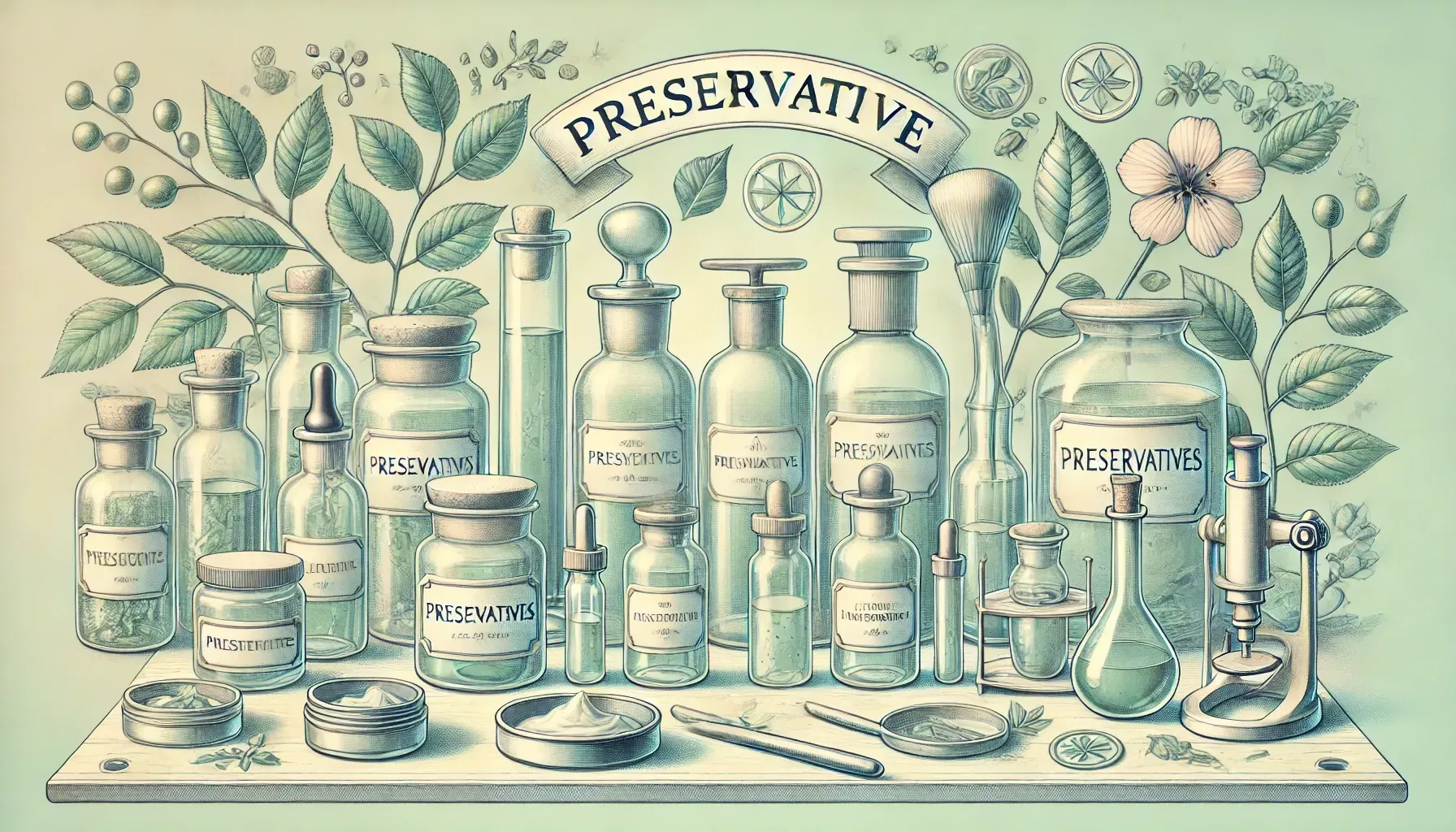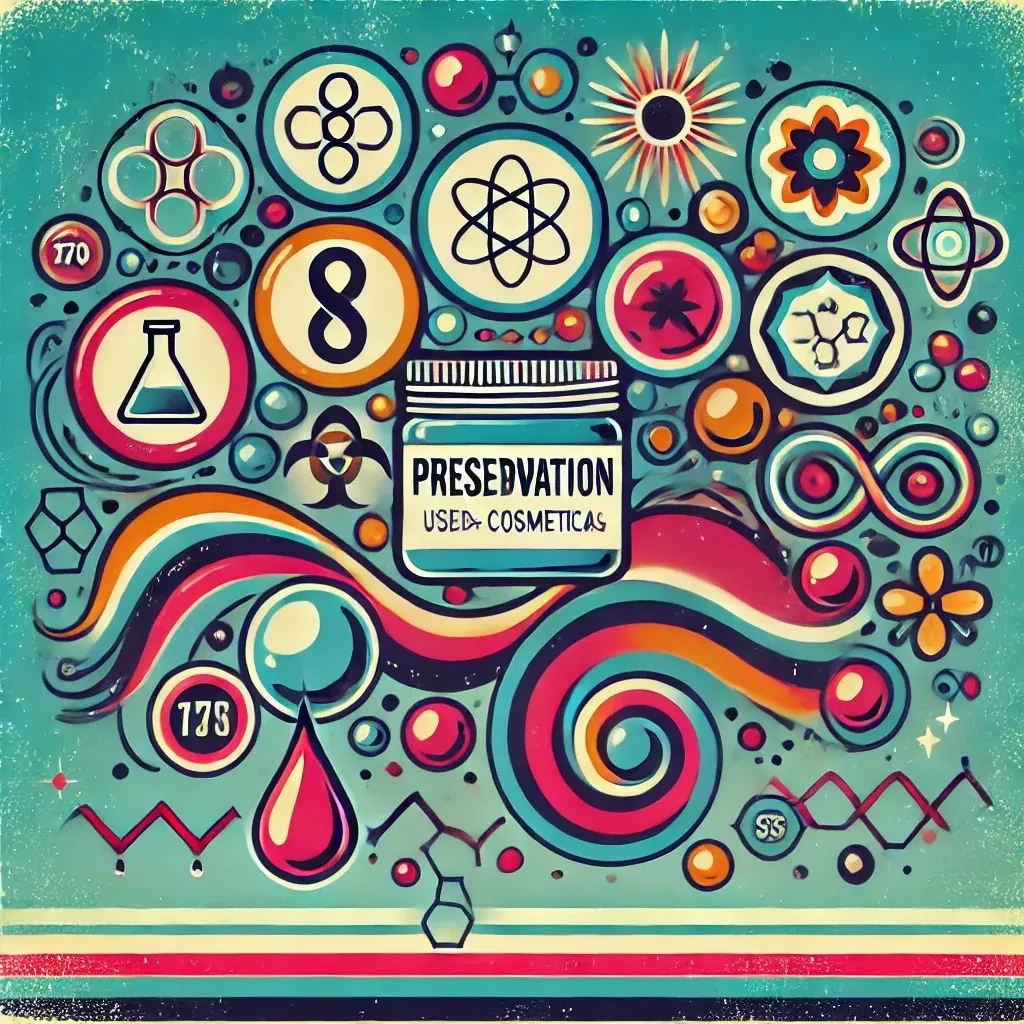Make sure your customized cosmetic products are protected with the best preservatives! At Chrambl we offer innovative and safe solutions for your product line. Get advice now and find the perfect preservation strategy for your cosmetic products.

Preservatives in cosmetics:
Protection and security for your products
Preservatives play a crucial role in cosmetics as they protect products from the growth of bacteria, fungi and mold. Without the use of these substances, products could quickly spoil and lose their effectiveness, which would endanger the safety of consumers.
Although preservatives are often viewed critically, they are essential in the correct dosage to keep cosmetic products stable and safe. In this article, you will learn everything you need to know about preservatives in cosmetics, their functions, and get to know 60 important preservatives.
Types of preservatives and their functions
1. Natural preservatives
Natural preservatives such as benzoic acid, sorbic acid and potassium sorbate are popular with environmentally conscious consumers. They provide protection against microbes and are generally less irritating to the skin. Although they are not as strong as synthetic preservatives, they still provide adequate protection for many cosmetic formulations.
2. Synthetic preservatives
Synthetic preservatives such as phenoxyethanol, parabens and triclosan are very effective and are often used in products that require a longer shelf life. However, these preservatives can cause skin irritation in high concentrations, so it is important that they are used in low, safe doses.
3. Parabens
Parabens such as methylparaben and propylparaben are widely used preservatives that have a very strong antimicrobial effect. They prevent the growth of bacteria and fungi. However, parabens have come under criticism in recent years because they can have hormonal effects in high concentrations. Therefore, paraben-free products are often preferred today.
4. Phenoxyethanol
Another commonly used preservative is phenoxyethanol, which is well tolerated and used in many creams and lotions. It protects against a wide range of microbes, but high concentrations can cause irritation.
5. Preservatives with multiple effects
Some preservatives, such as ethylhexylglycerin and caprylyl glycol, not only act as protection against bacteria and fungi, but also have a moisturizing effect. These ingredients have the advantage of providing additional care for the skin and not drying it out.
Are preservatives harmful?
Although many preservatives are viewed with skepticism, they are safe when used in the correct dosage and are essential for producing stable and safe products. Without preservatives, products could spoil quickly, which could endanger consumers' skin health. However, some preservatives have been criticized due to possible allergic reactions or hormonal effects. It is therefore important to pay attention to their concentration and possible side effects when selecting preservatives.
Preservation strategies for different products
The way in which preservatives are used in cosmetic products depends greatly on the formulation and intended use of the product. Water-based products such as creams and lotions require stronger preservatives because water is an ideal medium for the growth of microorganisms. Products that are not water-based, such as oils or solid cosmetic products, often get by with lighter or natural preservatives.
Future of Preservatives in Cosmetics
With the increasing awareness of natural and environmentally friendly cosmetic products, the development of new, mild preservatives is also being driven forward. Many manufacturers are already using natural alternatives to synthetic preservatives to offer products that are more suitable for sensitive skin types. Future trends could include new preservatives based on plant extracts or biotechnologically produced ingredients.
| Designation | INCI Name | application area | effect on the body |
|---|---|---|---|
| Benzalkonium Chloride | Benzalkonium Chloride | Shampoos | Antimicrobial, protective |
| Benzisothiazolinone | Benzisothiazolinone | hair care products | Protects against bacteria and fungi |
| benzoic acid | Benzoic Acid | creams, soaps | Protects against microorganisms |
| Benzylalkohol | Benzyl Alcohol | skin care products | Protects against bacterial growth |
| Caprylylglycol | Caprylyl Glycol | moisturizer | Moisturizing and antibacterial |
| Cetylpyridinium Chloride | Cetylpyridinium Chloride | oral care | Antimicrobial, protective |
| Chlorhexidindigluconat | Chlorhexidine Digluconate | oral care products | Antibacterial, prevents infections |
| Chlorphenesin | Chlorphenesin | face creams | Protects against bacteria and fungi |
| dehydroacetic acid | Dehydroacetic Acid | hair care products | Broad spectrum of activity against bacteria |
| Diazolidinyl Urea | Diazolidinyl Urea | lotions, creams | Protects against microbial contamination |
| Diethyl Phthalate | Diethyl Phthalate | fragrances | Protects against microbial decomposition |
| Dimethylol Dimethylhydantoin | Dimethylol Dimethylhydantoin | personal care products | Protects against microbial contamination |
| Ethylhexyl Methoxycinnamate | Ethylhexyl Methoxycinnamate | sunscreen products | Protects against UV light, stabilizing |
| Ethylhexylglycerin | Ethylhexylglycerin | moisturizer | synergist to other preservatives |
| Ethylparaben | Ethylparaben | face creams | Prevents the growth of bacteria |
| Glycerin | Glycerin | creams, soaps | Antibacterial |
| Glyceryl Caprylate | Glyceryl Caprylate | moisturizer | Protects against bacteria |
| Hexylene Glycol | Hexylene Glycol | skin care | Protects against bacteria and fungi |
| Iodopropynyl Butylcarbamate | Iodopropynyl Butylcarbamate | moisturizer | Protects against fungi and bacteria |
| Isoceteth-20 | Isoceteth-20 | Creams | Antimicrobial |
| Isopropylparaben | Isopropylparaben | hair care products | Prevents bacterial growth |
| potassium sorbate | Potassium Sorbate | personal care products | Prevents the growth of fungi |
| Lauryl Glucoside | Lauryl Glucoside | Shampoos | Antimicrobial, moisturizing |
| Levulinic Acid | Levulinic Acid | creams, lotions | Protects against microbial infections |
| Malic Acid | Malic Acid | moisturizer | Protects against microbial decomposition |
| Methylchloroisothiazolinone | Methylchloroisothiazolinone | Shampoos, Creams | Antimicrobial |
| Methylparaben | Methylparaben | Hautcremes, Shampoos | Antibacterial, protects against fungi |
| Natriumbenzoat | Sodium Benzoate | Shampoos, Conditioner | Protects against microbial infestation |
| Octenidine HCl | Octenidine HCl | oral care | Antibacterial effect |
| Designation | INCI Name | application area | effect on the body |
|---|---|---|---|
| Paraben | Paraben Mix | cosmetics in general | Prevents bacterial growth |
| Phenoxyethanol | Phenoxyethanol | creams, lotions | Antibacterial, prevents mold |
| Phenylpropanol | Phenylpropanol | moisturizer | Antibacterial, moisturizing |
| Polyaminopropyl Biguanide | Polyaminopropyl Biguanide | skin care | Protects against microbes |
| Polysorbate 20 | Polysorbate 20 | Creams | Stabilizing, protective |
| Potassium Benzoate | Potassium Benzoate | moisturizer | Prevents the growth of fungi |
| Propylene Glycol | Propylene Glycol | moisturizers | Protects against fungi and bacteria |
| Propylparaben | Propylparaben | skin and body care | Protects against bacteria and mold |
| Quaternium-15 | Quaternium-15 | Shampoos, Creams | Antibacterial, prevents mold |
| Resorcinol | Resorcinol | Haarfärbemittel | Antimicrobial, stabilizing |
| salicylic acid | Salicylic Acid | skin creams | Effective against fungi and bacteria |
| Sodium Dehydroacetate | Sodium Dehydroacetate | face creams | protection against bacteria and mold |
| Sodium Lactate | Sodium Lactate | skin care | Protects against microbial infections |
| Sodium Lauryl Sulfate | Sodium Lauryl Sulfate | soaps, shampoos | Protects against microorganisms |
| Sodium Metabisulfite | Sodium Metabisulfite | skin creams | Antioxidative and antibacterial effects |
| Sodium Methylparaben | Sodium Methylparaben | body care | Protects against microbial contamination |
| Sorbinsäure | Sorbic Acid | hair and skin care | Antifungal properties |
| Sorbitan Oleate | Sorbitan Oleate | Creams | Antibacterial, moisturizing |
| Tetrasodium EDTA | Tetrasodium EDTA | hair and skin care | Stabilizes and protects against microbes |
| Tocopherol | Tocopherol | skin creams | antioxidant |
| Triclosan | Triclosan | soaps, shower gels | Antibacterial and antimicrobial |
| Triethyl Citrate | Triethyl Citrate | hair care | Antibacterial, stabilizing |
| Triethylene Glycol | Triethylene Glycol | hair care products | Antimicrobial, stabilizing |






